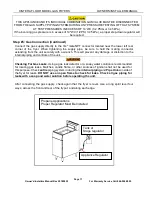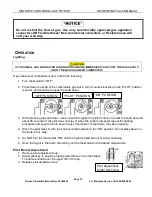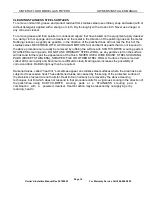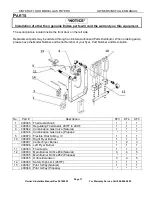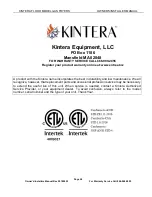
KINTERA FLOOR MODEL GAS FRYERS OWNER’S/INSTALLER MANUAL
Page 9
Owner’s/Installers Manual Rev 20180822 For Warranty Service Call 866-909-2855
Step #4: Check Clearances and Ventilation
Select a firm, level location for your fryer. Leave clearance, whenever possible, so that access from the rear
is possible to permit cleaning. If the unit is to be set on non-combustible flooring, such as a concrete slab, 3
inches minimum toe room must be provided to prevent restriction of the air opening in the bottom of the unit.
There must be adequate clearance between fryer(s) and construction. Clearance must also be provided
in front for servicing and for operation.
Minimum Clearances from Combustible Construction:
Sides: Six (6) Inches
Rear: Six (6) Inches
ALL KINTERA FRYERS SHALL BE INSTALLED WITH AT LEAST A 16 INCH SPACE BETWEEN THE
FRYER AND SURFACE FLAMES FROM ADJACENT EQUIPMENT. A FLAME GUARD IS
ACCEPTABLE IF ALLOWED UNDER LOCAL CODE.
“SUITABEL FOR INSTALLATION ON COMBUSTIBLE FLOORS”
No additional side and rear clearance is required for service as the fryer is serviceable from the front.
Improper ventilation can result in personal injury or death. Ventilation that fails to properly remove flue
products can cause headaches, drowsiness, nausea, or could result in death.
Unit Must be installed under a ventilation hood.
All units must be installed in such a manner that the flow of combustion and ventilation air is not
obstructed. Provisions for adequate air supply must also be provided. Do NOT obstruct the bottom front of
the unit, as combustion air enters through this area. Be sure to inspect and clean the ventilation system
according to the ventilation equipment manufacturer’s instructions.
Due to the variety of problems that can be caused by outside weather conditions, venting by canopies or
wall fans is preferred over any type of direct venting. It is recommended that a canopy extend 6" past the
appliance and the bottom edge be located 6'6" from the floor. Filters should be installed at an angle of 45° or
more from the horizontal. This position prevents dripping of grease and facilitates collecting the run-off
grease in a drip pan, unusually installed with a filter. A strong exhaust fan tends to create a vacuum in the
room and may interfere with burner performance or may extinguish pilot flames. Fresh air openings
approximately equal to the fan area will relieve such a vacuum. In case of unsatisfactory performance on
any appliance, check the appliance with the exhaust fan in the “OFF” position. Do this only long enough to
check equipment performance, then turn hood back on and let it run to remove any exhaust that may have
accumulated during the test.











